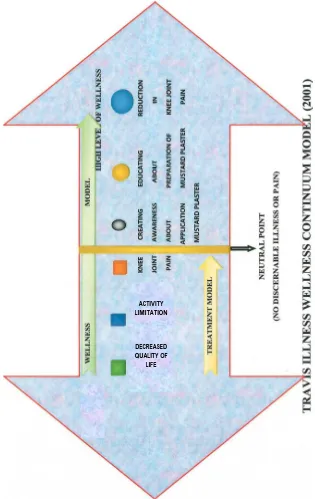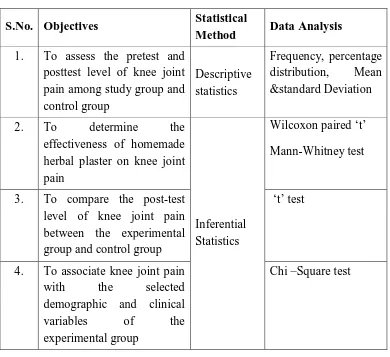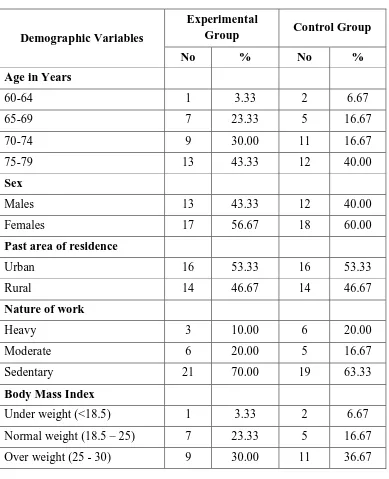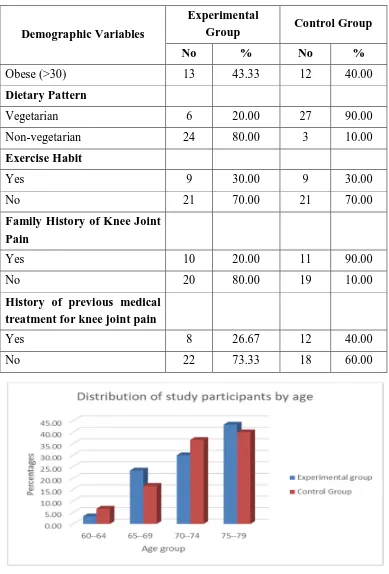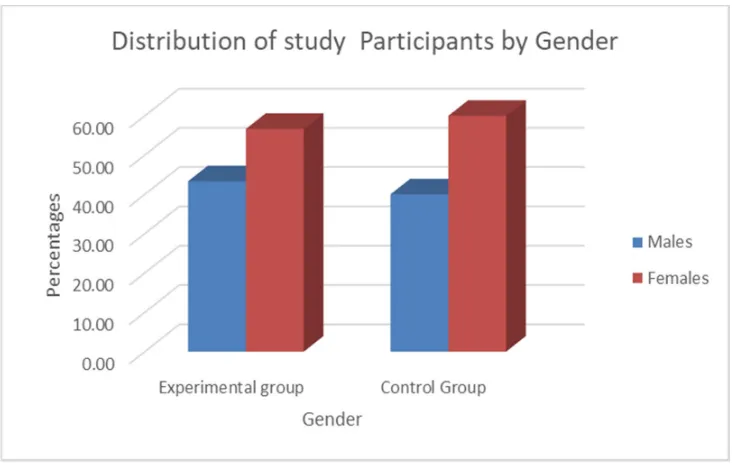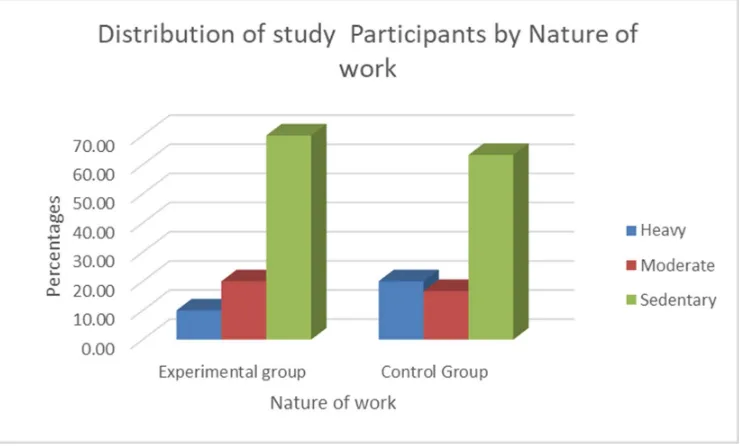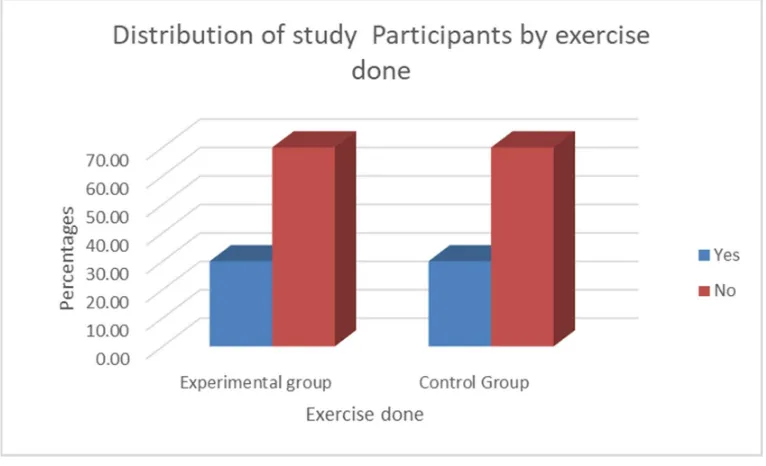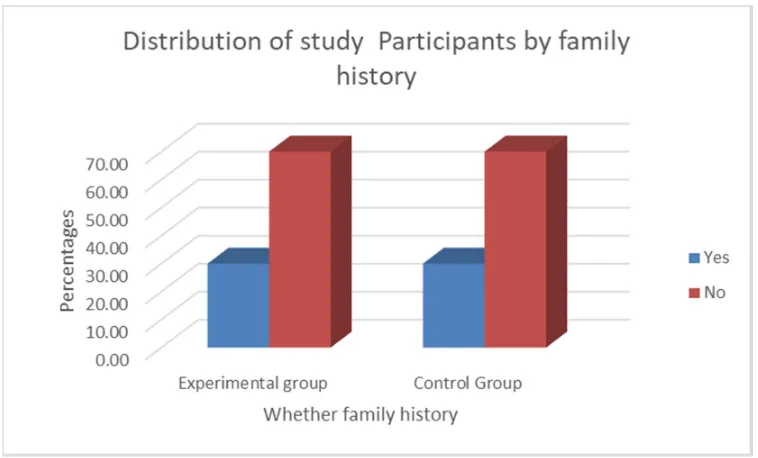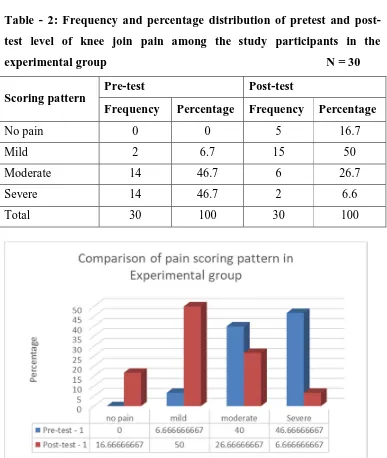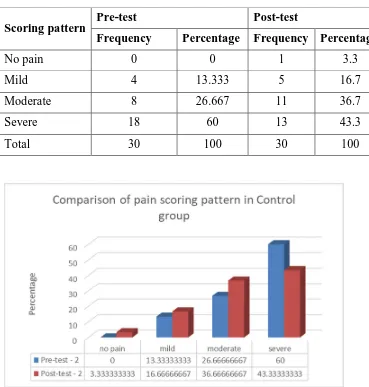A STUDY TO ASSESS THE EFFECTIVENESS OF
HOME MADE HERBAL PLASTER APPLICATION
ON KNEE JOINT PAIN AMONG ELDERLY
(ABOVE 60 YEARS) IN SELECTED
OLD AGE HOMES, CHENNAI
By
S.RAJESWARI
A dissertation submitted to
THE TAMILNADU DR.MGR MEDICAL UNIVERSITY, CHENNAI.
In the partial fulfillment of the requirement for the award of the degree of
MASTER OF SCIENCE
IN MEDICAL SURGICAL NURSING
A STUDY TO ASSESS THE EFFECTIVENESS OF
HOME MADE HERBAL PLASTER APPLICATION
ON KNEE JOINT PAIN AMONG ELDERLY
(ABOVE 60 YEARS) IN SELECTED
OLD AGE HOMES, CHENNAI
Certified that this is the bonafide work of
S. RAJESWARI
Mohamed Sathak A.J. College of Nursing, Chennai – 103.
Signature ………..
Dr. Prof. Mrs. R. RAMA SAMBASIVAN, M.Sc., (N)., Ph.D.,
Principal,
Mohamed Sathak A.J. College of Nursing
No.34, Rajiv Gandhi Road, (OMR) IT Highway, Siruseri Chennai – 603 103, Tamilnadu.
College Seal:
A dissertation submitted to
THE TAMILNADU DR.MGR UNIVERSITY CHENNAI
In the partial fulfillment of the requirement for the award of the degree of
MASTER OF SCIENCE IN MEDICAL SURGICAL NURSING
A STUDY TO ASSESS THE EFFECTIVENESS OF
HOME MADE HERBAL PLASTER APPLICATION
ON KNEE JOINT PAIN AMONG ELDERLY
(ABOVE 60 YEARS) IN SELECTED
OLD AGE HOMES, CHENNAI
Register No.
301511652
A Dissertation submitted to
THE TAMILNADU DR.MGR MEDICAL UNIVERSITY, CHENNAI
In the partial fulfillment of the requirement for the award of the degree of
MASTER OF SCIENCE
IN MEDICAL SURGICAL NURSING
OCTOBER 2017
A STUDY TO ASSESS THE EFFECTIVENESS OF
HOME MADE HERBAL PLASTER APPLICATION
ON KNEE JOINT PAIN AMONG ELDERLY
(ABOVE 60 YEARS) IN SELECTED
OLD AGE HOMES, CHENNAI
Approved by the dissertation committee on 02.06.2016Doctorate in Nursing Research
Dr. Prof. Mrs. R. RAMA SAMBASIVAN, M.Sc., (N)., Ph.D., Principal
Mohamed Sathak A.J. College of Nursing
No.34, Rajiv Gandhi Road, (OMR) IT Highway, Siruseri Chennai – 603 103, Tamilnadu.
Clinical Specialty Expert
Mrs. STELLA MARY, M.Sc., (N)
Head of the Department, Medical – Surgical Nursing Mohamed Sathak A.J. College of Nursing
No.34, Rajiv Gandhi Road, (OMR) IT Highway, Siruseri Chennai – 603 103, Tamilnadu.
Medical Expert
Dr. K.V.JEYAPRAKASH, M.S.Ortho Consultant Orthopedic Surgeon,
Annai Arul Hospital, No.270, Mudichur Road,
Old Perungalathur, Chennai – 600 063.
A dissertation submitted to
THE TAMILNADU Dr.MGR UNIVERSITY CHENNAI
in the partial fulfillment of the requirement for the award of the degree of
MASTER OF SCIENCE IN MEDICAL SURGICAL NURSING
ACKNOWLEDGEMENT
I take immense pleasure to express my gratitude to Lord almighty for
given me strength, direction, shield and blessing at each and every step
throughout the endeavor of this study.
I express my earnest gratitude to the MANAGEMENT,
MOHAMMED SATHAK A.J .COLLEGE OF NURSING.
I have an inclination to thank Dr.Prof.Mrs.Rama Sambasivan, M.Sc., (N)., Ph.D., (N)., Principal, Mohamed Sathak A.J.College of Nursing for her interest and excellent guidance, creative suggestions, timely help,
constant encouragement and support., Being guided by her has been a great
honour and privilege.
I wish to extend my immense thanks to Prof. Mrs. I. Safreena,
M.Sc., (N)., Vice Principal, Mohammed Sathak A.J. College for the Suggestions, Support and motivation which enlightened my way to complete
the work systematically.
I am also grateful and obligated to Mrs.Stella Mary, M.Sc., (N).,
Head of the Department, Medical Nursing, Mohamed Sathak A.J. College of
Nursing, for her profound help moral support, provoking stimulation,
elegant experience and critical suggestions in shaping my study.
My heartfelt thanks to Dr.K.V.Jeyaprakash, M.S. Ortho, Consultant Orthopedic Surgeon, Annai Arul Hospital for his expert guidance
in modification of tool and, Dr. M.D Vijayakumar, M.S(Ayu), Sanjeevi`s
ayush hospital for structuring the interventional procedure of this study
I am extremely thankful to the Managing Trustees of Amma - Appa
Old-age Care and Navajeevan Free Oldage Home for given me the
I also express my sincere thanks to Prof.Mrs. Prathiba, Associate
Professor, HOD Medical Surgical Nursing, Vekateswara Nursing College,
Prof.Mrs.A.Rathiga, HOD Medical Surgical Nursing, Chettinad College of Nursing for her expert opinion on the tool.
I extend my sincere thanks to N.K Balasubramanian, retired professor, Kerala University for his guidance in statistical analysis of data.
My sincere thanks to Mrs.Josephin.N. B.Ed., M.Phil., (Tamil Lit.)
for her guidance in Tamil Editing and Mrs.Meenakshi, M.A. M.Ed., (English Lit.) for editing the written text.
I also express my thanks to all the Faculty Members of Mohammed
Sathak A.J College of Nursing for the valuable suggestion and
encouragement in conducting this study.
I thank all Non-Teaching Staff members of Mohammed Sathak A.J.
College of Nursing for their timely help and support.
I am very grateful and thankful to my parents, husband, son and
friends for their understanding and continuous support throughout the study.
My sincere thanks to the participants who made this study possible
and successful. I thank each and everyone who have been a part for the
ABSTRACT
Pain is an unpleasant sensory and emotional experience associated
with actual or potential tissue damage, or described in terms of such
damage. Aging is a natural phenomenon that is experienced by all living
organisms. Healthy geriatric population makes major contribution to the
health and development of the country. Most of geriatric population is
troubled by chronic knee pain that has major effect on their quality of life. It
accounts for approximately one-third of musculoskeletal problems in this
population. High prevalence of knee joint pain is reported by various authors
i.e.46.7% among 60 years and above population and 40.7%among 65 years
and above. Under treated and poorly managed knee joint pain can affect
their physical, psychological, social and emotional life . Complementary
medicines are used in a variety of ways; some people use them instead of
conventional treatments, some alongside. Some people use them regularly
and some intermittently Evidence suggests that users of complementary
medicine feel non-toxic, holistic approaches to health. Herbal based home
remedies proven to be effective in joint pain and swelling. Mustard based
poultice is one of the best home remedy when applied with basil leaf powder
in a form of plaster. Mustard acting as a counter irritant and basil being the
best anti-inflammatory will be a cost effect also without any untoward
reactions.
Objectives
1. To assess the pretest and posttest level of knee joint pain among
experimental group and control group 2. To determine the
effectiveness of homemade herbal plaster application on knee joint
pain among experimental group 3. To compare the posttest level of
knee joint pain among experimental group and control group 4. To
associate the level of knee joint pain with the selected demographic
Methodology
An experimental study was conducted to assess the effectiveness of
homemade herbal plaster application on knee joint pain among elderly
(above 60 years). Quantitative research approach, Quasi experimental
research design was used on two selected groups conducting pre-test and
post-test studies. Study was carried out in Amma–Appa old age care
Mudichur, as Experimental group and Navajeevan old age home New
Perungalathur, as control group in Chennai. The data was collected using
self-structured questionnaire and WOMAC index with the help of numeric
rating scale for both study and control group and analyzed using mean
Results
In the experimental group, the pretest level of knee joint pain median was
50.000with sum of 1448.000, the posttest level of knee joint pain median
was 21.000 with the sum of 685. 000.The calculated paired ‘t’ value was
5.500 was statistically significant at p<0.01. In the post test comparison of
experimental group mean was 22.833 with S. D 14.809. In control group
mean was 44.1000 with S. D 17.674. The calculated ‘t’ value-5.052 found to
be statistically significant at p<0.01.
Conclusion
Thereby the investigator concludes that the application of home made
herbal plaster is effective on reducing the level of knee joint pain among
elderly (above 60 years). Hence, reduction of knee joint pain increases the
TABLE OF CONTENT
CHAPTERS PARTICULARS PAGE
NO.
I INTRODUCTION 1
Background of the study 4
Need for the study 7
Statement of the Problem 12
Objectives of the Study 13
Operational Definition 13
Hypothesis 14
Assumptions 14
Delimitation 15
Projected outcome 15
Human rights protection 15
Conceptual framework 15
II REVIEW OF LITERATURE 19
III METHODOLGY 27
Research Approach 27
Research Design 27
Setting of the Study 28
Population 29
Sample Size 29
Sampling Technique 29
CHAPTERS PARTICULARS PAGE NO.
Description of the Tool 30
Scoring Interpretation 31
Pilot study 32
Data collection method 32
Plan for data analysis 33
IV DATAANALYSIS AND INTERPRETATION 35
V DISCUSSION 49
VI SUMMARY, IMPLICATIONS AND
RECOMMENDATIONS
54
LIST OF TABLES
S.NO. TITLE PAGE NO.
1. Frequency and percentage distribution of
demographic variables of elderly with knee join
pain in experimental group and control group
36
2. Frequency and percentage distribution of pretest
and posttest level of knee join pain among study
participants in the experimental group
42
3. Frequency and percentage distribution of posttest
and posttest level of knee join pain among study
participants in the control group
43
4. Comparison of pretest and posttest level of knee
joint pain among study participants in
experimental group
44
5. Comparison of pretest and posttest level of knee
joint pain among study participants in control
group
44
6. Comparison of percentage change from pretest
score to post test score between experimental and
control group
45
7. Comparison between post test level of knee join
pain among elderly between experimental group
and study group
46
8. Association between level of knee join pain and
demographic variables
LIST OF FIGURES
FIGURE
NO. TITLE PAGE NO.
1. Conceptual framework based on TRAVIS
ILLNESS WELLNES CONTINUUM
MODEL
16
2. Schematic representation of research
methodology
34
3. Percentage distribution of age of the study
participants in experimental group and control
group
37
4. Percentage distribution of gender of study
participants in experimental group and control
group
38
5. Percentage distribution of past area of
residence of the study participants in
experimental group and control group
38
6. Percentage distribution of nature of work
(past) of the study participants in experimental
group and control group
39
7. Percentage distribution of BMI of the study
participants in experimental group and control
group
39
8. Percentage distribution of diet habit of the
study participants in experimental group and
control group
FIGURE
NO. TITLE PAGE NO.
9. Percentage distribution of exercise pattern of
the study participants in experimental group
and control group
40
10. Percentage distribution of family history of
the knee joint pain among study participants
in experimental group and control group
41
11. Percentage distribution of history of previous
medical treatment of study participants in
experimental group and control group
APPENDICES
S.NO. TITLE APPENDIX
1. RESEARCH QUESTIONNAIRE I
A) ENGLISH
B) TAMIL
2. PROCEDURE – HOME MADE HERBAL
PLASTER APPLICATION
II
3. CONTENT VALIDITY CERTIFICATE III
4. EXPERT CERTIFICATE FOR HOME MADE
HERBAL PLASTER APPALICATION
IV
5. CERTIFICATE FOR LANGUAGE PROFICIENCY V
6. PERMISSION LETTERS FROM OLDAGE HOME VI
CHAPTER – I
INTRODUCTION
“Being able to walk pain-free is a blessing. Being able to walk without showing the pain is a skill – Kylie Mc Pherson
Pain is the distressing feeling often caused by intense or damaging
stimuli. Because it is a complex subjective phenomenon, defining pain has
been a challenge. The international association for the study of pain, defines
pain is an unpleasant sensory and emotional experience associated with
actual or potential tissue damage, or described in terms of such damage. In
medical diagnosis, pain is regarded as a symptom of an underlying
condition.
The world’s older population continues to grow at an unprecedented
rate. Today, 8.5 percent of people worldwide (617 million) are aged 65 and
over. According to the report in “An Aging World: 2015 (link is
external)”, this percentage is projected to jump to nearly 17 percent of the
world’s population by 2050 (1.6 billion).
The share of India’s population ages 60 and older is projected to
climb from 8 percent in 2010 to 19 percent in 2050, according to the United
Nations Population Division (UN 2011). By mid-century, India’s 60 and
older population is expected to encompass 323 million people, a number
greater than the total U.S. population in 2012. This profound shift in the
share of older Indians—taking place in the context of changing family
relationships and severely limited old-age income support—brings with it a
variety of social, economic, and health care policy challenges.
Aging is a natural phenomenon that is experienced by all living
organisms. Healthy geriatric population makes major contribution to the
Those who survived to old age should be well informed about the ways to
prevent diseases and to maintain the quality of life to extend their survival.
Various diseases that commonly affect geriatric population are
musculoskeletal pain, heart diseases, and hypertension, diabetes, asthma and
skin diseases
Musculoskeletal pain is a major health problem among geriatric
population according to the surveys undertaken in both developed and
developing countries ,this is an epidemic which is destined to grow .Most of
geriatric population is troubled by chronic knee pain that has major effect on
their quality of life. It accounts for approximately one-third of
musculoskeletal problems in this population .High prevalence of knee joint
pain is reported by various authors i.e.46.7% among 60 years and above
population and 40.7%among 65 years and above .Under treated and poorly
managed knee joint pain can affect their physical, psychological ,social and
emotional life .
Marita Cross, Emma Smith (2010) the global burden of hip and knee osteoarthritis: estimates from the Global Burden of Disease 2010 study
globally, of the 291 conditions, hip and knee osteoarthritis was ranked as the
11th highest contributor to global disability.
Frank R. Noyes (1997) explained articular cartilage is a firm rubbery protein material covering the end of a bone. It acts as a cushion or shock
absorber between the bones. When articular cartilage breaks down, this
cushion is lost, and the bones will grind together. This causes the
development of symptoms such as pain, swelling, bone spur formation and
decreased motion. Osteoarthritis commonly affects weight bearing joints
such as the knee, but it may affect any joint. Osteoarthritis of the knee (OA
Knee) is one of the five leading causes of disability among elderly men and
Felson DT, Naimark A, Anderson J (1993) stated that the risk for disability from OA Knee is as great as that from cardiovascular disease.
Here are some frequently asked questions about OA Knee. OA Knee usually
occurs in knees that have experienced trauma, infection or injury. A smooth,
slippery, fibrous connective tissue called articular cartilage acts as a
protective cushion between bones. Arthritis develops as the cartilage begins
to deteriorate or is lost. As the articular cartilage is lost, the joint space
between the bones narrows. This is an early symptom of OA Knee and is
easily seen on X-rays. As the disease progresses, the cartilage thin,
becoming grooved and fragmented. The surrounding bones react by
becoming thicker. They start to grow outward and form spurs. The
synovium (a membrane that produces a thick fluid that helps nourish the
cartilage and keep it slippery) becomes inflamed and thickened. It may
produce extra fluid, often known as "water on the knee," that causes
additional swelling.
Over a period of years, the joint slowly changes. In severe cases,
when the articular cartilage is gone, the thickened bone ends rub against
each other and wear away. This results in a deformity of the joint. Normal
activity becomes painful and difficult. Several factors may increase the risk
of developing osteoarthritis of the knee like weight, gender, trauma and
other illness .
Times of india.com (2009) the high incidence of knee joint pain is prevalent among post-menopausal women as estrogen levels go down, they
lose that protection and may have a higher risk of developing osteoarthritis
and joint pains even if they are in hormone replacement therapy (HRT)
These real-life consequences of knee joint pain need to be given
adequate attention in the home care settings. So, there is a need to have
component of health self–management, with a rich tradition, particularly for
who have limited access to medical care or discrimination by health care
system.
Haug`s model of self-care and Leventhal`s (2009) common-sense model of self-care regulation (CSM), predicts that older adults will use a
variety of forms of self-care to alleviate commonly experienced symptoms
.Home remedies are substances used to treat common symptoms and
ailments .They can be divided in to food products and readily available non
–food household products common among people in the world.
BACK GROUND OF THE STUDY
Complementary and alternative medicines are a group of diverse
medical and healthcare systems, practices and products that aren't presently
considered to be part of conventional medicine. Alternative therapies for
knee and other joint pains include such as acupuncture, copper bracelets,
glucosamine, chondroitin supplements, naturopathy, yoga, chiropractic,
homeopathy, hypnotherapy and medical herbalism.
Complementary medicines are used in a variety of ways; some
people use them instead of conventional treatments, some alongside. Some
people use them regularly and some intermittently Evidence suggests that
users of complementary medicine feel non-toxic, holistic approaches to
health. More over they're 'natural', and harmless with less side effects, and is
locally available in living area. Many people with arthritis look to these
alternative therapies to help relieve the pain, stiffness, stress, anxiety, and
depression that accompany their disease. The Arthritis Foundation reports
that two-thirds of people with joint pain have tried alternative therapies
Many researchers have studied and recommended the application of
mustard based herbal plaster for centuries mustard plasters were tried and
until the not too distant past since this poultice was thought to sweat out all
the “ills” the body held. Allyl isothiocyanate is an active ingredient found in
the mustard plaster that is, absorbed through the skin as a transdermal drug
responsible for the pain relief on joints. Allyl isothiocyanate, which is the
organ sulfur compound, is a counterirritant. meaning that it stimulates nerve
endings in the skin and thereby distracts the body from deeper seated pain.
Breana Noble (2004) a treatment from the Indian ayurvedic tradition, holy basil (Ocimum basilicum) also known as tulsi, meaning “The
Incomparable One”.
It is one of the sacred herbs traditionally used in the India and
frequently grown at home. As adaptogen, it helps the body to work at its
prime level even while under large amounts of stress by regulating the
creation of stress hormone including cortical and adrenaline, the magazine
explained. It contains high amount of anti-inflammatory elements and
antioxidants, helpful in fighting joint pain, natural news reported. These
properties come from eugenol in the oil found from the plant`s leaves,
according to Healthy newsage.com
Poultices, compress and plasters are wonderful way of applying an
herbal treatment externally to a specific area of the body. They are very like
each other, and are both easy and effective in treating many common
household ailments. Plasters are very powerful and it should be applied in
thin layers to protect the skin and the area monitored to avoid any skin
reactions to strong herb (like mustard, cayenne, garlic and ginger).
Hippocrates has prescribed mustard as a medicine for pulmonary illness and rheumatism. The use of mustard plant for medicinal purposes
goes back to the several millenniums. Mustard has been used as food and
Mustard was used in Europe for centuries for both medicinal and
culinary purposes and was brought to this country by European settlers,
mustard seeds were once used in the U.S pharmacopeia list of approved
medication and were included in baths, plaster and massage oils. Mustard
preparation is widely available commercially and mustard powder widely
used by U.S army in management of pain.
Debra Rose Wilson (2010), treatment for arthritis aims to improve joint movement and eliminate pain and swelling. Doctor will likely
recommend a combination of treatments that include different medications
and physical therapy. Surgery is typically used as a last resort.
Nicola Conville (2002), said that several varieties of fresh basil have been found to be as strong as anti-inflammatory medication when it comes
to easing the swelling and pain of arthritis, according to a new study
conducted in India. Researchers found that when taken orally, concentrated
extracts from the two types of basil - Ocimum americanum and Ocimum
tenuiflorum - reduced joint swelling up to 73 per cent in 24 hours. “When
assessed the anti-inflammatory capacity of both plants it was found that the
actions were found like diclofenac, an anti-inflammatory drug that is used in
the treatment of arthritis," says the lead researcher Vaibh Shinde. "Research
indicates that eugenol, the oil that gives basil its distinctive aroma, is the
active molecule responsible for the anti-inflammatory effect." These types of
basils are grown mainly in India and South-East Asia
Since herbal based home remedies proven to be effective in joint pain
and swelling. Mustard based poultice is one of the best home remedy when
applied with basil leaf powder in a form of plaster. Mustard acting as a
counter irritant and basil being the best anti-inflammatory will be a cost
NEED FOR THE STUDY
WHO bulletin, Worldwide estimates provided were that 9.6 % of men and 18% of women aged above 60 years had symptomatic
osteoarthritis. 80% of those with osteoarthritis had limitations in movement.
Also, it was observed that 25% could not perform their major daily activities
due to pain. Radiographic studies conducted in U.S and European
populations showed that people aged 45 years above were facing the risk of
osteoarthritis of knee It could be known from the survey that studies on tibia
femoral joint, osteoarthritis of the patella femoral joint which have major
impacts were limited. The burden will be greatest in the developing
countries, where the life expectancy is increasing .Access to arthroplasty and
joint replacement is not readily available as per the fact sheet published in
2009 in UK , in every 5 adults are suffering from arthritis 4.4 million in UK
have X ray evidence of osteoarthritis in hands 5,50,000 have complaint in
knees and 2,10,000 have complaint at hip, prevalence of arthritis is higher in
females (227/1000),it is twice than of men (113/1000). In Europe 100
million people (14.5% of population) reports arthritis related disability
(2010).In Asia 6 million Japanese (5% of population) have osteoarthritis, the
incidence rate of arthritis is 0.42%
In India, osteoarthritis is the second most common rheumatologic
problem and it is the most frequent joint disease with a prevalence of 22% to
39%. OA is more common in women than men. Nearly 45% of women over
the age of 65 years have symptoms while 70%of those over 65 years show
radiological evidence of OA in India .The prevalence of OA is increasing
due to population aging and an increase in related factors such as obesity,
sedentary life style .The physical disability arising from pain and loss of
functional capacity reduces quality of life and increase the risk of further
morbidity. As highly effective medicinal management not available
symptomatic relief which is again with the concern of GI ,cardiovascular
and nephrological adverse effects with the long term use.
The available surgical procedures like Arthrodesis in which two
damaged bones are joined to prevent the joint from bending, Arthroscopy,
the loose cartilage and bone fragments removed to make the rough joint
surface smooth, and joint replacement surgeries in ,replacing the ends of
bones in a damaged joint which creates new joint surfaces. According to
advanced health center 2009 of university of Delaware (UD) indicates that
patient who has undergone total knee arthroplasty (TKA) need to learn the
proper technique of moving from sitting to standing position, an additional
physiotherapy and activity limitation.
CIMS (2011) the main aim of arthritis management is pain relief among joint mobility. Pharmacological management of pain using
acetaminophen and NSAIDS causes side effects including gastrointestinal
disorders, hepatic and renal damage serious GI complications such as
bleeding, ulceration and perforation can occur with or without warning in
people who use NSAIDS ,every day it is estimated that more than 100,000
Americans are hospitalized each year below 15,000 and 20,000 American
die each year from ulcers and GI bleeding linked to NSAIDS use of
particular concern are patients with arthritis. More than 14 million such
patient consumes NSAIDS regularly up to 60% with have GI side effects
related to these drugs and more than 10% will stop taking recommended
medication because of trouble some GI symptoms (American college of
gastroenterology 2013).
Holistic Online.com (2011) Mustard is well known for its counter irritant, anti-congest ant action, practices have proven that increased
circulation and reduces pain relief at application site .Mrs. Mary betts
Sinclair has conducted clinical trial successfully in reducing joint pain
Cims (2010) found even though arthritis is distressing disease, we can manage the patient condition and help them to lead a full and active life.
There are many measures used to relief the symptoms such as analgesic to
decrease the pain, nonsteroidal anti-inflammatory drugs to relief pain and
inflammation. But the side effects caused by these drugs include cause
gastrointestinal and renal complications. In these context, natural remedies
for pain relief that is free of any side effects will be more help full for
clients.
Tipnut.com (2009) for centuries mustard plasters were tried and true home remedy for the flu, and joint ailments. It was used regularly up until
the not too distant past since this poultice was thought to sweat out all the
“ills” the body held. Allyl isothiocyanate (AITC) is an active ingredient
found in the mustard plaster that is responsible for arthritic pain relief along
with other forms of arthritic joint pain. Allyl isothiocyanate (AITC), which
is the organosulfur compound, is a counterirritant.
Small, Ernest (2009) Herbal plaster is a poultice of mustard seed powder and basil leaf powder spread inside a protective dressing and applied
to the body to stimulate healing. It can be used to warm muscle tissues and
for chronic aches and pains.[1] It was once part of conventional medical treatment] and available in prepared versions in pharmacies. It fell from favor in the 20th century and is now only used as a home remedy
There are many solutions for overcoming arthritis joint pain, and one
of them is a mustard based herbal plaster. A herbal plaster is a poultice that
is made up of dry mustard seed powder and dry basil leaf powder which is
kept inside a protective dressing. It is applied to the painful areas for
stimulating healing. The plaster can be used for warming muscle tissues and
Web med (2010) Mustard is an easily available and comparatively cheap material .it causes no side effects when compared with any other
medications. There is no need for any activity restriction or any dietary
restriction for clients using mustard plaster. Moreover, it can be prepared
and administered at home that enables client self-care and control over his or
her devastating joint pain. Application of heat relieves joint discomfort.
Mustard plaster application works primarily through chemical action of
mustard and secondarily by the action of heat, it reduces muscle stiffness.
Gernot Katzer in his special article Basil is an important medicinal plant in various traditional and folk systems of medicines, such as those in
Southeast Asia and India. Holy basil is usually referred to as tulsi in India
and is considered a sacred herb. It’s been used in over 300 different
Ayurvedic herbal treatments for thousands of years, including tinctures, teas,
ointments and tonics. Tulsi is also an important symbol in many other Hindu
religious traditions and is linked to the goddess figure;
When researchers from the Medical University of Lodz in Poland
tested the antibacterial activity of basil oil against strains of E. coli and other
powerful bacteria that were gathered from sick patients with infections, the
results showed that basil was effective in acting against the bacteria strains
and helping to inhibit their growth. (5) This has led researchers to continue
to study how basil and other antibacterial oils may help fight antibiotic
resistant illnesses and infections.
Rammanohar (2009) Mustard oil is applied externally in management of abdominal swelling, skin disease, epilepsy and frozen
thighs. Mustard seed is included in the group of drugs that cleanse or relief
the congestion in the head sinuses used for decoction enema, have
anti-prurient activity and induces emesis in skin, leprosy, fever, epilepsy,
Holistic.com (2009) there is a need for the improved comfort and support for arthritis client clinically trial is going on in the alternative
therapies for arthritis. Current pharmacological management of osteoarthritis
includes the administration of analgesics and NSAIDS but their use does not
provide adequate pain relief or block the disease progression some new
disease modifying agents, especially the anti TNF and anti IL-1 agents have
shown some promise but they are not effective universally and possess
several side effects such as life-threatening infections and malignancies
which limit their use in many populations.
Arthritis herbal medicine (2009) Mustard piaster is a popular counter irritant treatment for arthritis the substance in mustard is Allyl
isothiocyanate it has antifungal and anti-microbial activity isothiocyanates
can inhibit the carcinogenesis in breast, colon and lung (journal of
traditional knowledge 2009).
Herbal extract plus.com (2009) Mustard, naturally available seed is powdered and made as the plaster by mixing with wheat flour and tepid
water and applied over painful joint, relieves pain well .It is the counter
irritant and causes no side effects. Improvement were made on mustard
plaster are gaining acceptance in arthritis care, now mustard plaster are
available commercially.
Mrs. Mary betts Sinclair (2009) has demonstrated the clinical application of mustard plaster for joint pain and frozen shoulder in her book
of hydrotherapy, she has introduced the use of mustard plaster for
osteoarthritis. "The complete book of water healing" author Dian Buchman
also recommended the use of mustard plaster for osteoarthritis as pain relief
Hannelore.R. Levy and Dr.Reinhard R Bergel (2008), in their book spa encyclopedia has mentioned about the use of mustard in relieving
pain .Due to its counteraction, wide presence, easy availability, affordability
and safety, mustard is best choice. Action of mustard is counter irritant that
is distracts the nerve endings and there by helps in reduction of pain
perception and transmission. In mustard plaster, action is primarily from the
grounded mustard, but also due to the application of thermal heat over the
plaster, both the mustard and heat improves circulation and soothes the
stiffness and painful muscles and tendons. The action of mustard causes
mild irritation to the skin, stimulating the circulation in affected area and
relieving muscular and skeletal pain. Mustard paste with water is applied has
the analgesics in the case of rheumatism, sciatica, paralysis of limbs and
other muscular pains.
Research is opening up new avenues of treatment for the people with
osteoarthritis and joint pain. The most obvious and loud able reason for
doing clinical research is, of course to benefit the patient, the benefits should
always out of risk, the current treatment modalities for arthritis pain are
having more risk than benefits. In this context, there is need for safety
treatments. Homemade herbal plaster offer relief to those suffering from
joint pains without causing side effects. They will improve the quality of life
for people with osteoarthritis and their families since this fact has to be
proved and presented for the pleasure of geriatric population with knee joint
pain, the study is very significant.
STATEMENT OF THE PROBLEM
A STUDY TO ASSESS THE EFFECTIVENESS OF HOMEMADE
HERBAL PLASTER APPLICATION ON KNEE JOINT PAIN AMONG
ELDERLY (ABOVE 60 YEARS) IN SELECTED OLD AGE HOMES,
OBJECTIVES OF THE STUDY
1. To assess the pretest and posttest level of knee joint pain among
experimental group and control group.
2. To determine the effectiveness of homemade herbal plaster
application on knee joint pain among experimental group.
3. To compare the posttest level of knee joint pain among experimental
group and control group.
4. To associate the level of knee joint pain with selected demographic
variables.
OPERATIONAL DEFINITIONS EFFECTIVENESS
In this study, effectiveness refers to the positive outcome expected by
the researcher in reduction of knee joint pain after application of homemade
herbal plaster among study participants as measured by adapted WOMAC
Index Questionnaire with numeric rating scale.
HOME MADE HERBAL PLASTER
The plaster is prepared by mixing two table spoon of dry mustard
powder, 1 table spoon of dry basil powder with four table spoon of wheat
flour mixing with luke warm water. The paste is then spread over the clean
cotton cloth and edges of the cloth are folded in wards to form the plaster,
plaster is then applied to the painful joint and hot water bag (110-degree F)
is provided on top for 20 minutes.
KNEE JOINT PAIN
In this study, it refers to the uncomfortable subjective feeling over the
affected knee joint as the result of knee stress or pathological degeneration
of articular cartilage in elderly as measured by adapted WOMAC index
ELDERLY
In this study, it relates to persons in their later life, 60 years or above.
Old AGE HOMES
It refers to a nursing home – a multi residence housing facility
intended for senior citizens
HYPOTHESIS
H1: There is significant difference in the level of knee joint pain between study group and control group
H2: There is a significant difference in the level of knee joint pain after homemade herbal plaster application in experimental group
H3: There is significant difference in the level of pain between study group and control group after homemade herbal plaster application
H4: There is a significant association between knee joint pain with selected demographic variables
ASSUMPTIONS
Pain is an individual, subjective experience that is measurable and
can be effectively evaluated by individuals who are experiencing
pain.
Knee joint Pain threatens well-being and cause limitations in daily
activities
Among the counter irritant and anti-inflammatory products used for
the knee joint pain relief, homemade herbal plaster is an effective
agent
DELIMITATIONS
The study is limited to the patients who can read Tamil and English
The sample size is limited to only 60 subjects
The duration of the study is limited to 6 weeks
PROJECTED OUTCOME
The projected outcome of the study is that, patients with knee joint
will have
Reduction of knee joint pain
Increased functional ability in performing activities of daily living
Better quality of life
HUMAN RIGHTS PROTECTION
The pilot study and the main study were conducted after getting the
approval from the ethical committee.
Permission was obtained from the management of Amma-Appa old
age home, Mudichur and Navajeevan free old age home,
Newperungalathur
The purpose and other detail of the study were explained to the study
subjects and oral consent was obtained from the patients
CONEPTUAL FRAMEWORK
The theoretical model found most appropriate for the study is Travis's
Illness Wellness Continuum Model developed By Travis Ranges from High
level of wellness to deformity (Travis and Ryan 2001 functional ability).
The illness wellness continuum illustrates the relationship of the
shows a progressively worsening state of health. Moving to the right of the
center indicates increasing levels of health and wellbeing .The treatment
[image:30.595.151.466.177.676.2]paradigms
Fig.1 Conceptual Framework Based on Travis Illness Wellness Continuum Model (2001)
ACTIVITY LIMITATION
DECREASED QUALITY OF
THE TWO ARROWS OF THE MODEL
The model illustrates two arrows pointing in opposite direction and
joined at neutral point, the relationship of the treatment paradigm to the
wellness paradigm.
1. TREATMENT PARADIGM
Signs
Symptoms
Disability
2. NEUTRAL POINT
3. WELLNESS PARADIGM
Awareness
Education
Wellness
4. HIGH LEVEL OF WELLNESS
SIGNS
Indicates the Knee Joint Pain in this Study.
SYMPTOMS
Indicates activity Limitations in this Study
DISABILITY
In This Study the Disability Indicates Inability of the Client to
AWARENESS
In This Study Awareness Is Creating or Emerging Knowledge about
Application of Herbal Plaster to the Study Participants.
EDUCATION
In This Study Education Is Described as the Imparting Knowledge to
the Study Participants about the Preparation of homemade herbal plaster
WELLNESS
It Is Attained by the Client after Application of the Herbal Plaster
Results in Reduction of Knee Joint Pain.
HIGH LEVEL OF WELLNESS
Movement of arrow towards Right Side Indicates obtaining High
Level of health by wellbeing of the patient this is achieved in three steps,
they are creating awareness about application of herbal plaster, educating
about homemade plaster application and after application there will be
CHAPTER-II
REVIEW OF LITERATURE
Reviewing of literature is an important step in the development of a
research project. The written literature review provides the reader with a
back ground for understanding what has already been learnt in a topic and
illuminates what is significant in the new study (Polit & Hungler). Keeping
this in mind the investigator probed into the accessible sources and gained in
depth understanding from the related studies. It gives a theoretical base for
the research and helps to determine the nature of research. Literature
relevant to the present study was mentioned under the following headings:
The Review of Literature Grouped into Two Sections
Section A - Studies Related to knee joint pain among old age
Section B - Studies Related to homemade herbal plaster (mustard and basil) and home remedies for joint ailments
International journal of health sciences (2014) knee joint arthritis is a common progressive joint disease, involving not only the joint lining but
also cartilage, ligaments, and bone. For the last ten years, majority of
published review articles were not specific to osteoarthritis of the knee, and
strength of evidence and clinical guidelines were not appropriately
summarized.
Rheumatic disease clinic of North America (2012) Osteoarthritis is the most prevalent form of arthritis in the United States, affecting more than
70% of adults between 55 and 78 years of age. Women are affected more
than men. Hip osteoarthritis is more common in Western populations,
suggesting that race and environmental factors might also be important. The
incidence of symptomatic knee osteoarthritis is 1% per year, with a
has been estimated at about 4% per year. Osteoarthritis (OA) is estimated to
affect 630 million people worldwide - 15% of all the people on the globe.
Michael C. Nevitt, (2011) arthritis prevalence is approximately 6.1% for knees in U.S. adults who are aged 30 and older; thus,
approximately 12 million persons have symptomatic knee osteoarthritis
Because, of its prevalence, knee joint pain due to cartilage generation has
major impact on the burden of disability in older Americans. OA is ranked
as either the top or second leading cause of disability among elders
Epidemiology is the study of the occurrence of disease in populations and its
association with characteristics of people and their environments.
Epidemiologic studies have provided much information about the
occurrence of OA. Disease in the knee is common, especially among the
aged; hip OA is less prevalent in most populations than disease in the knee;
and for disease in the hand, and radiographic OA is nearly universal in older
people, whereas symptoms are less frequent. Studies have also shown that,
for most joints, women who are older than 50 have a higher incidence and
prevalence of disease than men. Throughout the United States and Europe,
the prevalence of OA and its societal burden in terms of disability and
economic costs is high. These critical data serve one important role of
epidemiologic studies, to estimate disease impact and the need for resource
allocation.
Ann JVI Lynch (2011) Knee joint pain, the leading cause of disability among older adults in the United States. Treatment options such
as acetaminophen and nonsteroidal anti-inflammatory drugs are the most
widely used agents to manage mild-to-moderate pain. Treatment with
Tramadol or Opioids is usually reserved foils severe pain associated with.
These agents do not come without risk, especially for older adults.
Patient-specific parameters and co morbid conditions must be considered when
John Carey (2010). Significant disability and loss of function are associated with the joint pains especially knee arthritis and its management
is an enormous cost to the health care system. Rather than one uniform
disease, osteoarthritis may be a primary or an idiopathic phenomenon, or it
may be secondary to some other disorder. Osteoarthritis is also commonly
seen as a secondary form of arthritis in patients with other inflammatory
arthritis, such as rheumatoid arthritis. Mechanical and genetic factors play
roles in the development of this disease as well. Histological evidence
clearly shows ongoing inflammation and cartilage destruction in
osteoarthritis, although not to the same degree as in other arthritis, such as
rheumatoid arthritis.
John Hopkins arthritis center (2010) common joint disorder with symptoms in the hands, knees, hips, back, and neck. It is unclear exactly
how excess weight influences OA. Clearly, being overweight increases the
load placed on the joints such as the knee, which increases stress and could
possibly hasten the breakdown of cartilage, For example, it is estimated that
a force of nearly three to six times one's body weight is exerted across the
knee while walking; an increase in body weight increases the force by this
amount, However, overweight has also been associated with higher rates of
hand OA in some studies suggesting, the involvement of a circulating
systemic factor as well.
Framingham, (2010) overweight individuals in their thirties who did not have knee OA were at greater risk of later developing the disease. Other
investigations, which performed repeated x-rays over time also, have found
that being overweight significantly increases the risk of developing knee
OA. It is estimated that persons in the highest quintile of body weight have
up to 10 times the risk of knee OA than those in the lowest quintile.
significantly lower risk of knee OA. For a woman of normal height, for
every 11 lb. weight loss (approximately 2 BMI units), the risk of knee OA
dropped > 50%. Conversely, a comparable weight gain was associated with
an increased risk of later developing knee OA (odds ratio 1.28 for a 2 BMI
weight gain). The investigators concluded that in elderly persons, if obese
men (i.e., BMI greater than 30) lost enough weight to fall into the
overweight category (BMI 26-29.9) and men in the overweight category lost
enough weight to move into the normal weight category (BMI less than 26),
knee OA would decrease by 21.5%. Similar changes in weight category by
women would result in a 33% decrease in knee OA. A handful of studies
have indicated that weight loss substantially reduced reports of pain as well.
Thus, weight loss potentially offers an important modifiable factor in the
behavioral treatment of knee OA.
Susan Bartlett, (2009) Knee osteoarthritis (OA) is common in older adults. Determination of risk factors for onset of knee OA may help in its
prevention. The systematic review, and meta-analysis, was to determine the
current evidence on risk factors for knee OA. A systematic literature search
was carried out for cohort and case-control studies evaluating the association
of demographic, co morbid, and other patient-determined factors with onset
of knee OA. A scoring tool was developed to assess the quality of studies.
Heterogeneity of studies was examined. Where possible studies were pooled
to give an overall estimate of the association of factors with onset of knee
OA. Of the 233 studies screened, 85 were eventually included in the review.
Study quality tended to be moderate. The main factors consistently
associated with knee OA were obesity (pooled OR 2.63, 95% CI 2.28-3.05),
previous knee trauma (pooled OR 3.86, 95% CI 2.61-5.70), hand OA
(pooled OR 1.49, 95% CI 1.05-2.10), female gender (pooled OR 1.84 95%
CI 1.32-2.55) and older age. Smoking appeared to have a moderate
protective effect; however, this was not evident once the analysis was
revived, more longitudinal studies are needed to investigate the association
of physical occupational and other patient-determined factors with future
knee OA. The quality of such studies also needs to be improved. However,
there are identifiable factors which can be targeted for prevention of
disabling knee pain.
Ann Rheum (2009) cartilage degeneration is the single most common cause of disability in older adults, and most patients with the
condition will be managed in the community and primary care. A literature
search identified studies of incidence and prevalence of knee pain, disability,
and radiographic osteoarthritis in the general population, and data related to
primary care consultations. Findings from UK studies were summarized
with reference to European and international studies. During a one-year
period 25% of people over 55 years have a persistent episode of knee pain,
of whom about one in six in the UK and the Netherlands consult their
general practitioner about it in the same time period. The prevalence of
painful disabling knee osteoarthritis in people over 55 years is 10%, of
whom one quarter is severely disabled. Knee osteoarthritis sufficiently
severe to consider joint replacement represents a minority of all knee pain
and disability suffered by older people. Healthcare provision in primary care
needs to focus on this broader group to impact on community levels of pain
and disability.
SECTION B STUDIES RELATED TO HERBAL PLASTER APPLICATION
Everydayhealth.com/arthritis (2014) In modern scientific studies, some of these arthritis cures have proven to be effective, An easy way to use
mustard seed for joint pain relief, Make a plaster with warm mustard seed
oil and applying it to swollen, arthritic joints found to be effective reduction
in knee joint pain frankincense provided patients with knee osteoarthritis
Jeffrey M. Weinberg (2012) Mustard seeds have been used in traditional folk medicine as a stimulant, diuretic, and purgative and to treat a
variety of ailments including peritonitis and neuralgia. Mustards are still
used today in mustard plasters to treat rheumatism, arthritis, chest
congestion, aching back, and sore muscles. To make a mustard plaster, mix
equal parts of flour and powdered mustard and spread it as a paste on a
doubled piece of soft cloth. Apply mustard plaster to the affected area for a
maximum of 15 minutes. Despite the advances in medicine, a tendency
towards using alternative treatments can be seen in every population,
including the Turkish one, and plant application is among the most common
hoods used in folk medicine.
Tokifumi Majima (2010),
conducted a study on
Effect of the Japanese herbal medicine, ‘Boiogito’, on the osteoarthritis of the knee withjoint effusion. Japanese herbal medicine contains ‘sinomenine’ which
inhibits inflammatory reactions. Study was performed using 50 patients who
were diagnosed with primary osteoarthritis of the knee with joint effusion.
The patients were randomly assigned to two groups: one group (25 patients)
using both loxoprofen (2-{4-[(2-oxocyclopentyl) methyl]} propanoic acid)
and ‘Boiogito’ and the other group (25 patients) using loxoprofen, and were
evaluated during a 12-week observation period.
H Yabanoglu (2012), Arthritis has been afflicting humans for a long time according to some reports, as far back as 4500 B.C, and our ancestors
used many natural remedies to treat arthritis pain. In modern scientific
studies, some of these arthritis cures have proven to be effective in relieving
joint pain. Apply mustard plaster to the affected area for a maximum of 15
minutes. Helps the client to relief from the osteoarthritis pain
Edward et al., (2011), tried successful mustard as a topical treatment for arthritis. The study group contained 90 arthritis clients. Mustard oil was
indicated a significant reduction in joint pain among the participants studies
related osteoarthritis and alternative therapy.
Edelstein B (2011) a randomized trial on treatment effect of mustard oil massage compared to relaxation tape recordings on long term
musculoskeletal pain. This randomized clinical trial was to assess the
possible effects of mustard oil massage as compared to listening to
relaxation tape on musculoskeletal pain. During treatment, there was
significant improvement in self rated heath, mental energy and pain reducing
only in the mustard oil massage group as compared to relaxation group.
Laurence (2010) applied an apparatus with incorporates a cooling compartment (mustard) encircling the head, extended down to the neck and
a separate warming compartment is applied to the vertex was employed in
28 clients with recurrent headaches. Findings of the study reveal that
severity of the head ache was reduced after application of the mustard pack.
Krasnegor J (2010) conducted study on benefits from massage therapy in juvenile rheumatoid arthritis. children with mild to moderate
juvenile rheumatoid arthritis cured massaged using mustard oil by their
parent 15mins a day for 30 days. The children's immediately reducing pain
by mustard oil massage were assessed by self-reports, parents reports their
physician assessment of pain and pain limiting activities.
Simons et al., (2009) conducted study on mustard oil differential effects on the trigeminal caudalis neurons to heat and acidity, they found
that, when applied to the oral or mucosal mustard oil evokes a desensitizing
pattern of irritation. They investigated the response of neurons in superficial
laminar of trigeminal subcutaneous caudalis to noxious thermal (53c) and
chemical (pentatonic acid) prior to the and following lingual mustard oil
application the data suggest that the effect of mustard oil on subsequent
Norwich UK (2009) A research was done on human colorectal cancer cells at institute of food research intestinal and functional health
group. They reported that mustard yield an anticancer chemical when
cooked. The chemical called allyl-isothiocyanate the uncontrolled cell
division of colon cancer cells and may protect against other cancers, notably
lung cancer.
Jorg et al., (2009) found that topical application of mustard oil to the skin activities underling sensory nerve endings thereby reducing pain and
inflammation hypersensitivity to thermal and mechanical stimuli. Mustard
oil depolarizes a sub population of primary sensory neurons. These findings
identify a cellular and molecular target for the pungent action of the mustard
oils and support emerging role for TRP channels as ionotropic cannabinoids
receptors.
NaturaI Medicine Comprehensive Database, (2009) Mustard (Brassica) topically, used as a poultice for bronchial pneumonia, pleurisy,
arthritis, lumbago, aching feet, rheumatism, and as a counterirritant to treat
inflammation and joint pain Topical Preparation of mustard plaster; 100
grams of mustard flour mixed with warm water to make a paste. Put mustard
paste into linen and apply for 10 minutes has Generally Recognized as Safe
CHAPTER – III
RESEARCH METHODOLOGY
INTRODUCTION
(Polit 2008) The methodology of the research study is defined as the
way the patient information is gathered in order to answer the research
question or analyses the research problem .It enables the researcher to
project a blueprint of the research undertaken. This chapter on methodology
includes research approach, research design, setting, population of the study,
criteria for the selection of sample, sample size, sampling technique,
description of the tool, and validity of the tool, pilot study, data collection
procedure and plan for data analysis.
RESEARCH APPROACH:
The research approach chosen for this study was Quantitative
Research Approach
RESEARCH DESIGN
Research design is the plan for obtaining an answer, to the research
questions for testing the research hypothesis (Polit and Hungler1999)
Quasi Experimental Design was adapted was adopted for this study to assess the effectiveness of homemade herbal plaster application and knee
THE SCHEMATIC REPRESENTATION
Group Pretest Intervention Post test
Study group 01 X 02
Control group 01 - 02
Key
01 –To assess the pretest level knee joint pain among patients with knee join pain in the experimental group and control group
X – Homemade herbal plaster application.
02- Post-test level of pain in the experimental group and control group
VARIABLES
Independent variable is homemade herbal plaster application on knee joint.
Dependent variable in this study level of knee joint pain among elderly (above 60 years)
SETTING
This study was carried out in Amma–Appa old age care, Mudichur,
Chennai and Navajeevan free old age home, Chennai
Amma-Appa old age home located in Kombi amman nagar, opposite
to BP petrol pump, Mudichur, Chennai. More than 50 aged and disabled
residing in calm and lively atmosphere in the home. Medical assistance, well
balanced diet, individual attention with trained staffs, spiritual relief makes
the inmates live a happy life with confidence and independence. Cordial
relationship of founder and other workers towards home inmates makes the
Navajeevan free old age home is located in Vivekananda Street near
perungalathur railway station, New perungalathur. It is a heavenly place for
the senior citizens to live a full, worry free life in their retirement years, in
the serene atmosphere. There are 60, both men and women senior citizens
from in and around Chennai live there .Apart from food and shelter ,special
medical facilities, spiritual growth Centre, fine entertainment options gives
a premier lifestyle option that makes aging a real privilege .
POPULATION:
Population is the entire population in which researcher is interested
and would like to generalize the results of the study. (Polit and Beck 2004).
Population of the study includes elders (above 60 years) with knee
joint pain in Amma – Appa oldage care, Mudichur, Navajeevan free old age
home, Newperungalathur, Chennai
SAMPLE SIZE:
The size of the study was 60 elderly people with knee joint pain (30
sample to experimental group and 30 sample to control group)
SAMPLING TECHNIQUE:
Sampling technique refers to the process of selecting a portion of the
population to represent the entire population (Polit and Hungler, 1999)
In this study, non probability convenience sampling technique was
used to select the sample.
CRITERIA FOR SELECTINGTHE SAMPLE:
The sample selection based on the following inclusion and exclusion
INCLUSION CRITERIA:
The study includes elderly above 60 years
Elders with mild to severe knee joint pain
Both male and female participants
Person who could speak and understand Tamil and English language
who were willing to participate
EXCLUSION CRITERIA:
Person with cognitive and sensory impairment.
Persons with chronic conditions such as bone cancer and septic
arthritis.
Patients with extreme knee joint pain
Patients on medical treatment or takes analgesics for knee joint pain
Elders who are included in the pilot study.
DATA COLLECTION TOOL
DESCRIPTION OF THE TOOL
SECTION I: Consists of questions to elicit demographic data such as age, gender, nature of work and area where they resided before coming to the
home
The WOMAC Index (Western Ontario Mc Master University Index)
Questionnaire is used to assess patients with knee joint pain.
24 parameters are arranged under 2 subscales as pain and difficulty in
performing daily activities there are 5 responses with scoring
from 0-4.
The score was interpreted as follows:
Score in Percentage Rating
1 -24% Mild
25-48% Moderate
49 -72% Severe
73-96% Extreme
TESTING OF THE TOOL:
VALIDITY
Content validity was ensured by giving tool to 2 nursing experts in
the field of medical and surgical nursing 1 medical expert. Correction was
made according to the expert`s opinion and guidance. Tool is validated and
widely accepted as standardized tool.
RELIABILITY:
Reliability is the degree of consistency or dependability with which
instrument measures the attribute is designed to measure. (Polit and Hungler,
1999)
The reliability of the tool was tested by test –retest method. r value is
got as 0.963. Hence the tool was considered highly reliable for proceeding
PILOT STUDY
Pilot study was conducted in the AMMA -APPA old age care after
obtaining permission from the management. Following which data was
collected from six persons above 60 years with knee joint pain who fulfilling
the inclusion criteria.
The severity of knee pain was assessed using WOMAC Index.
Patients were given homemade herbal plaster application along with hot
water bag (110-degree F) application for 20 minutes. The post test was
conducted on 7th day using WOMAC Index questionnaire with numeric rating scale. The results were analyzed.
The following modifications were done after the pilot study:
1. Objectives minimized to 4 out of 6
2. Those who were taking medical treatment for joint pain are added in
exclusion criteria
DATA COLLECTION PROCEDURE
Study was conducted in Amma-Appa old age care and Navajeevan
free old age home after obtaining formal permission from the home
management. Data collection was done for a period of 6 week from
21.11.2016 to 31.12.2016 ,60 samples were selected using non-probability
convenience sampling technique.
After explaining the purpose of the study, oral consent was obtained
from the samples. Confidentiality of the information collected was assured.
In pretest information collected about demographic and clinical
variables using self-structured questionnaires, level of pain is assessed using
For experimental group, the plaster is prepared by mixing two table
[image:47.595.107.497.379.736.2]spoon of dry mustard powder, 1 table spoon of dry basil powder with four
table spoon of wheat flour mixing with Luke warm water. The paste is then
spread over the clean cotton cloth and edges of the cloth are folded in wards
to form the plaster, plaster is then applied to the painful joint and hot water
bag (110-degree F) is provided on top for 20 minutes. Freshly prepared
plaster is applied once a day for 7 consecutive days. For control group only
routine care was given
After 7 days, the same WOMAC index questionnaire with numeric
rating scale was used to assess the pain level in both experimental and
control group.
PLAN FOR DATA ANALYSIS
S.No. Objectives Statistical
Method Data Analysis 1. To assess the pretest and
posttest level of knee joint pain among study group and control group
Descriptive statistics
Frequency, percentage distribution, Mean &standard Deviation
2. To determine the
effectiveness of homemade herbal plaster on knee joint pain
Inferential Statistics
Wilcoxon paired ‘t’
Mann-Whitney test
3. To compare the post-test level of knee joint pain between the experimental group and control group
‘t’ test
4. To associate knee joint pain with the selected demographic and clinical
variables of the
experimental group
Research Design Quasi experimental design
Study Setting
Amma-Appa Old Age Care And Navajeevan Free Old Age Home
Population
Elderly People(above 60 years) with Knee Joint Pain
Sampling Technique
Non probability convenience sampling technique
Sample Size
60 elderly people with knee joint pain
Experimental group Control Group
Pre-test: Description of Instrument
Demographic variables -self-structured questionnaire, Adapted WOMAC index
Homemade herbal plaster application Routine Care
Data analysis –By Descriptive and inferential statistics
Reduction of knee joint pain level No significant change in knee joint pain level
CHAPTER -IV
DATA ANALYSIS AND INTERPRETATION
This chapter deals with analysis and interpretation to assess the
effectiveness of homemade herbal plaster on knee joint pain among elderly
(above 60 years) in selected old age homes, Chennai.
Descriptive and inferential statistics used for the analysis of the data.
According to the study objectives the interpretation had been tabulated and
organized as follows
ORGANIZATION OF DATA
SECTION A: Description of demographic variables of study participants with knee joint pain among experimental and control group
SECTION B: Assessment of pretest and post-test level of knee joint pain among study participants in experimental group and control group
SECTION C: Effectiveness of homemade herbal plaster on knee joint pain among study participants in the experimental group
SECTION D: Comparison of post-test level knee joint pain among study participants between the experimental and control group
